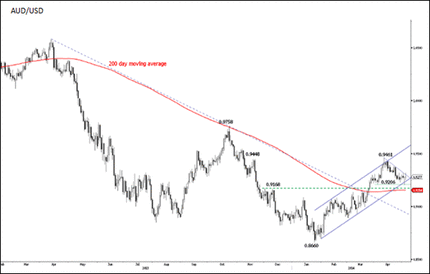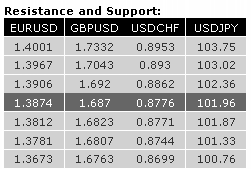Forex News and Events:
The Friday’s surprise in US payrolls couldn’t generate a stable demand in USD holdings; the dovish FOMC dominates the overall sentiment. The US 10 year government yields traded below 2.60% for the first time in three months. In Australia, the weakness in Chinese manufacturing weighs on AUD before RBA verdict (on Tue) and Chinese trade data due this week. EUR and GBP well recovered to pre-NFP levels and trade ranged before BoE and ECB meetings (on Thu). The implied vol in G7 hit the 7 year lows. The Turkish Lira is the biggest winner among EM, as the fastening inflation keeps the CBT doves subdued this Monday.
ECB and BoE meetings
The ECB and the BoE will meet on Thursday. Both central banks are expected to keep the policy rates unchanged at the current historical low levels. The ECB President Draghi’s monthly press conference will be the main focus point. We believe that the latest improvement in Euro-zone CPI estimates will be an excellent reason to not act, yet we will be chasing more details on a potential QE to counter the EUR-strength. This raises a downside risk in EUR-complex, which is relatively cheap to hedge on the option markets currently, given that the 1-month implied vol stands at the seven year lows (appr. 5-5.5%).
AUD highly exposed to China, RBA to keep the status quo
The RBA will give policy verdict on Tuesday and is widely expected to keep the policy rate unchanged at 2.50%. The softness in first quarter CPI should give flexibility to Australian policy makers to remain on their dovish position especially given the weakness in China. The HSBC final PMI read at 48.1 shows that the manufacturing activity in China remains in the contraction zone and the AUD is among the most vulnerable currencies vis-à-vis the soft Chinese recovery. We will be closely monitoring the Chinese trade data this week. Weakness in Chinese imports should further weigh on AUD-complex. In fact, China represents over one thirds of Australia’s total trade activity and roughly 65% of iron ore and coking coal exports. The AUD exposure to Chinese activity is thus noteworthy and the growing iron core inventories in China suggests no significant recovery in Chinese demand in the close future.
AUD/USD is currently stuck within 0.9209-0.9339 range (Fibonacci 50% and 61.8% on Oct’13 - Jan’14 drop), the negative bias places the lower band at higher risk this week. The key support is seen at 200-dma (0.9154).
Versus the kiwi, the selling pressures intensify on concrete RBA/RBNZ divergence. AUD/NZD will step into the broad downtrend channel for a close below 1.0680. The key support is seen at 1.0540 (March support), then 1.0493 (2014 low).
Turkey inflation tops at 9.38% in April
Turkey CPI y/y accelerated at the faster-than-expected pace of 9.38% in April, the CPI core hit 9.74%. As expected, the rising food prices (due to winter drought) are now quantifiable in inflation figures and should intensify in the coming three months before the expected ease in inflation begins. USD/TRY sold-off below 2.1000 post-CPI as expectations of a CBT cut faded given the price dynamics. The upside pressures in inflation raise our fears combined to the possibility of a rate cut in the coming months. We now see intensifying policy risk – a “too early rate cut from the CBT” - and underweight TRY holdings.

Today's Key Issues (time in GMT):
2014-05-05T13:45:00 USD Apr F Markit US Services PMI, exp 54.5, last 54.22014-05-05T13:45:00 USD Apr F Markit US Composite PMI, last 54.9
2014-05-05T14:00:00 USD Apr ISM Non-Manf. Composite, exp 54, last 53.1
The Risk Today:
EUR/USD continues to consolidate after its rise from 1.3673 (04/04/2014 low) to 1.3906 (11/04/2014 high). The technical structure remains supportive as long as the support at 1.3780 (09/04/2014 low) holds. Furthermore, Friday's intraday bullish reversal confirms a persistent buying interest. A key resistance lies at 1.3906. An hourly support can now be found at 1.3812 (02/05/2014 low). In the longer term, EUR/USD is still in a succession of higher highs and higher lows. However, the recent marginal new highs (suggesting a potential long-term rising wedge) indicate an exhausted rise. As a result, we see a limited upside potential, especially given the key resistance at 1.3967 (13/03/2014 high).
GBP/USD has broken the key resistance at 1.6823, opening the way for a test of the major resistance at 1.7043. Despite the recent weakness, no rising trendline has been broken. Supports stand at 1.6807 (30/04/2014 low) and 1.6763. An hourly resistance lies at 1.6920. In the longer term, prices continue to move in a rising channel. As a result, a bullish bias remains favoured as long as the support at 1.6661 (15/04/2014 low) holds. However, we are reluctant to suggest an upside potential higher than the major resistance at 1.7043 (05/08/2009 high), especially given the general overbought conditions.
USD/JPY's intraday bearish reversal on Friday has invalidated the potential short-term bullish technical structure (ascending triangle). The support 101.87 is challenged. A key support lies at 101.20. Hourly resistances can now be found at 102.36 (intraday high) and 103.02. A long-term bullish bias is favoured as long as the key support area given by the 200 day moving average (around 101.02) and 101.33 (11/04/2014 low, see also the rising trendline from the 93.79 low (13/06/2013)) holds. A major resistance stands at 110.66 (15/08/2008 high).
USD/CHF remains weak as can be seen by the breach of the support at 0.8771 (see also the rising trendline). Another support can be found at 0.8744. A break of the key resistance at 0.8862 is needed to negate the current short-term bearish momentum. From a longer term perspective, the structure present since 0.9972 (24/07/2012) is seen as a large corrective phase. However, a decisive break of the key resistance at 0.8930/0.8953 is needed to validate a bullish reversal pattern.

